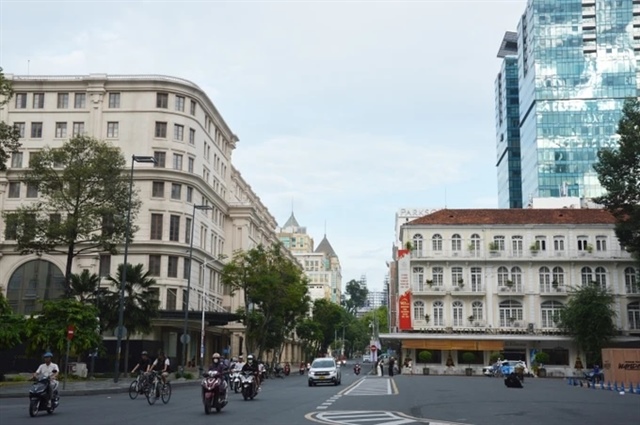|
Major cities among most costly retail destinations
Ho Chi Minh City and Hanoi are reported to be among the most expensive destinations for retail brands in prime locations.
In 2024, Dong Khoi street in Ho Chi Minh City remained one of Vietnam’s most expensive retail destinations, ranking 14th globally, according to Cushman & Wakefield.

Dong Khoi Street - view towards Notre Dame Cathedral, source: sggp.org.vn
|
A report released in November revealed that retail rents on Dong Khoi street reached $330 per square metre per month, up 32 per cent compared to pre-pandemic levels, but down 6 per cent on-year, primarily due to fluctuations in the local currency against the US dollar.
Trang Bui, country head of Cushman & Wakefield Vietnam, said that Vietnam’s luxury retail market was experiencing significant growth, drawing the attention of numerous international brands.
“Dong Khoi, in particular, is one of the busiest and most well-known streets in Ho Chi Minh City, located near high-end hotels and major tourist attractions, which helps attract a significant number of affluent consumers. Many luxury brands have chosen Dong Khoi to open stores and position their brands in Vietnam. Being present on this street enables these brands to reach target customers while maintaining and enhancing their premium image,” Bui said.
Rental prices on other streets in District 1 of Ho Chi Minh City are also reported to be high.
Last month, Starbucks confirmed plans to relocate its flagship store to the Bitexco building on Hai Trieu street, near the Nguyen Hue pedestrian axis. The store is scheduled to open in the first half of 2025, with a monthly rent of around $41,600. This is around double the monthly rent of its previous location in District 1.
In Hanoi, Trang Tien street ranks 18th in the Asia-Pacific region for retail rental prices, with rents reaching $300 per sq.m per month. This marks a 50 per cent increase compared to pre-pandemic levels and remains unchanged from last year.
Since the opening of Vietnam’s first shopping malls, including Trang Tien Plaza in Hanoi and the Tax Trade Centre in Ho Chi Minh City, retail supply initially started at around 30,000sq.m.
Between 1996 and 2019, the market added an average of 97,000sq.m of retail space annually, peaking from 2013 with an annual average of 195,000sq.m of new space. However, the past five years have seen a slowdown in supply, especially in central areas, leading to increased rental prices. By Q3 of 2024, the total retail supply in Ho Chi Minh City and Hanoi had reached approximately 2.56 million sq.m.
The Cushman & Wakefield report highlighted that brands, from luxury to mass market, are investing heavily in prime physical locations to create superior shopping experiences and showcase products.
“While e-commerce plays a role in omnichannel strategies, the physical presence of a brand remains critical for customer engagement. As a result, vacancy rates are exceptionally low, driving rents higher as retailers compete for prime locations,” the report stated.
The 34th edition of Global Retail Avenues focused on 138 of the world’s most exclusive urban retail avenues, featuring exclusive data from Cushman & Wakefield.
According to Tran Pham Phuong Quyen, senior manager of Savills Ho Chi Minh City Retail Leasing Department, the city’s fashion market is becoming increasingly vibrant with the arrival of many international brands.
“Vincom Dong Khoi has recently welcomed Urban Revivo and Karl Lagerfeld, while the Saigon Centre has attracted Longchamp, Lush, and a second Popmart store,” Quyen said.
However, Quyen noted that some brands face challenges entering the Ho Chi Minh City market due to limited space in District 1 and lengthy licensing procedures.
“Vietnam benefits from a young population and a market of over 100 million people. In major cities, young consumers are quick to adapt to new trends, have rising living standards, and seek to express themselves. These factors make the market highly attractive to retail, food, and entertainment brands,” Quyen said.
She added that rental prices in central districts are now 2-3 times higher than those in secondary districts, with a much larger gap compared to other cities.
“Central rental prices are expected to increase steadily next year, while suburban areas may face challenges as tenants remain concentrated in necessities, services, and food sectors. Fashion and retail brands are hesitant to open stores in emerging residential areas,” Quyen said.
As of Q3/2024, Savills Research reported that modern retail projects in Ho Chi Minh City maintained an occupancy rate of 94 per cent, up 0.5 percentage points on-quarter and 4 percentage points on-year.
Major tenants such as Mr. DIY, Uniqlo, and Muji have expanded in non-CBD (central business district) areas due to lower rents and high population density. Key projects like Hung Vuong Plaza, AEON Mall, and Van Hanh Mall consistently maintained 100 per cent occupancy thanks to high visitor traffic, diverse tenants, and effective management.
The average ground floor rental price in Ho Chi Minh City is about $58 per sq.m per month, reflecting increases of 4 per cent on-quarter and 6 per cent on-year.
VIR
|